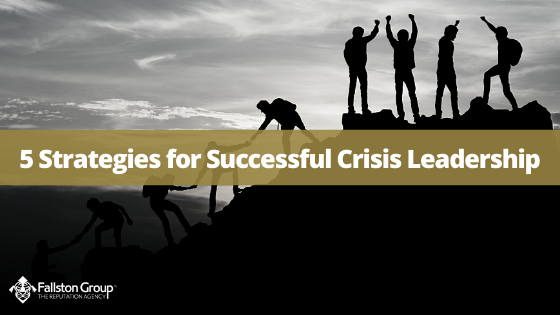5 Strategies for Successful Crisis Leadership

by Rob Weinhold, Chief Executive of Fallston Group When it comes to crisis, it isn’t a matter of if but of when. Having an effective crisis management strategy in place is critical not only for weathering the storm but for rebuilding as quickly as possible afterward. These five strategies will help you minimize damage and maximize recovery. Embrace and seize the moment. Short-term adversity can be a long-term advantage if you are able to meet the moment with impact. Look for ways to make your company bigger, faster and stronger than before. As a leader, you have the ability to make an immediate and valuable difference. While everyone does make mistakes, people trust those who handle crisis with the honesty, decisiveness and optimism it deserves. Yes, optimism! Follow the Resilient Moment Communications model. The underpinning of success is the ability to communicate effectively, especially in dire, unexpected circumstances. The Resilient Moment Communications model, developed by Dr. George Everly, Jr., Ph.D., one of the founding fathers of the modern era of stress management, provides an excellent communications blueprint: What happened? What caused it? What are the effects—realized and anticipated? What is being done about it? What needs to be done in the future? If you can fully answer the above questions during times of crisis or adversity, you will have answered the key questions the overwhelming majority of people have during life’s most critical times – you will provide effective leadership. Stay present. Incredible leaders emerge when the chips are down and there is seemingly no way out. The lesson that has always remained with me is the power of presence. The ability to look someone in the eye with empathy and compassion during adversity is critical. You must ensure you and your company are ready to meet the moment, no matter how uncomfortable or unpleasant. Certain life occurrences will yield themselves whether you are there or not. Be ready to meet the moment with vigor, transparency and, again, decisiveness. Be predictive with the press. When it’s time to address the media, be certain to plan for every question and eventuality. There is a tendency for CEOs to want to go on camera without fully preparing because they are used to speaking publicly and know the organization very well. Avoid this temptation and list all possible questions, answers, follow-ups and counters. Train on camera, relentlessly. An eight to fifteen-second sound bite can ruin your reputation, and career. Don’t wing it. Prepare for every interview and press conference no matter how mundane or harmless it may seem. Again, train relentlessly as in this digital age there is no such thing as a local news story any longer. Plan your work, work your plan, stay the course. Once a plan to deal with a crisis situation is put in place, remain true to your vision, conviction and the plan’s ability to perform. This is key. Staying the course is essential in any crisis, once an effective plan is defined. Mid-course correction is sometimes necessary but always have a plan that’s straightforward, easy to understand, easy to execute and scalable at a moment’s notice. During times of sensitivity, adversity or crisis, the most important thing you can do is step up, be present, and answer the tough, yet important, questions. Even better, be prepared before a crisis so you and your company will know what to do during and after – you must create organizational muscle memory – many people are depending on you to lead them through the storm. Always remember Fallston Group’s mantra, “If you don’t tell your story, someone else will. And, when someone else tells your story, it certainly won’t be the story you want told.” Be first. Be fast. Be accurate! Crisis isn’t a matter of if but of when, and when crisis strikes your company or organization, being a competent ambassador and leader during a crisis are critical components to you and your organization’s longevity.
